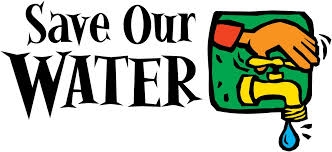
Depending upon local conditions and near-term weather, irrigation may not be needed for a month or more.
"We can reap twice as much from the latest storms if people take full advantage of the natural precipitation and shut off sprinklers," said Department of Water Resources Director Mark Cowin. "Three dry years in a row have left our major reservoirs low, and we need to conserve those supplies in case drought conditions persist into the next rainy season. There's no need to water lawns, parks, median strips, or any landscaping already soaked by these recent storms."
On January 17, Governor Edmund G. Brown Jr. declared a drought emergency in California and called on all residents to conserve water by 20 percent in their homes and businesses. Typically more than half of the water used by homeowners is used outdoors. Californians can go a long way toward meeting the governor's goal by shutting down sprinklers until soil several inches deep appears dry or plants appear stressed. People who resume landscape irrigation should do so only according to the water schedules set by their local water districts. More than 100 such districts around the state have imposed voluntary or mandatory conservation measures that restrict the days and times when residents can run sprinklers.

Tom Gohring, executive director of the Water Forum, a diverse group of Sacramento regional interests working to resolve water issues, hosted the event at his home and switched off the sprinkler system controller in his garage to encourage others to do the same.
"Many people think they use more water in their house than they do in their yard," said Gohring. "The opposite is typically true. In the Sacramento region, about 65 percent of water used by homeowners goes to irrigate landscaping. We always want people to adjust their sprinklers based on the season and weather, but now, after a record dry year, there's real urgency."
While recent storms have boosted the Sierra Nevada snowpack and runoff into reservoirs, it would take half an inch of rain every day of March from Redding to Bakersfield to bring the state to average precipitation for the year in the watersheds that supply much of California's drinking and irrigation water. Even average precipitation would not be enough to avert water shortages, because major reservoir storage is now so far below typical storage for this time of year.
“Storms in the last couple of weeks have delivered a couple of inches or more of precipitation to most parts of California,” said Chuck Ingels, UC Cooperative Extension advisor in Sacramento County. “Trees, shrubs, flowers, and lawns naturally use less water in winter's cool temperatures, and so an inch of rain provides enough moisture to forego the need for sprinklers for up to several weeks depending on temperatures.”
Sprinkler systems are controlled by a device, called an irrigation controller, that triggers the irrigation system when to turn on and off. People who do not know how to program their controllers can get links to manuals published by major manufacturers at the Save Our H2O website, saveourH20.org. Look under the "Sprinklers 101" section of the website: http://www.saveourH20.org/sprinklers101
Sacramento residents can find their water provider, information on the latest water restrictions, and water-saving tips at the Regional Water Authority's “Be Water Smart” website at http://www.bewatersmart.info/residential-customers/.
University of California master gardeners offer tips for gardening during a drought at http://cagardenweb.ucanr.edu. The California Center for Urban Horticulture, UC Davis, also has information for conserving water in the landscape, http://ccuh.ucdavis.edu, as does the UC Davis Arboretum http://publicgarden.ucdavis.edu/public-garden/drought-resources.
Other smart watering tips detailed at the Save Our H2O website:
- Water only in the early morning or late evening. Cooler temperatures reduce evaporation.
- Check your sprinkler system frequently and adjust so that you are not watering the hose, sidewalk, or street.
- Put mulch around trees and plants to cool soil and reduce evaporation.
- Consider installing a drip irrigation system, which applies water precisely, with less waste.
- Choose plants based on their adaptability to your climate. Check the Sunset Plant Finder to learn about water-wise plants that thrive in your region: plantfinder.sunset.com/plant-home.jsp.
- If you find yourself walking on your lawn only to mow it, consider replacing it with water-wise landscaping that reduces the need for water and maintenance.
- Check with your local water district for a free visit from a water conservation specialist, rebates on water-wise appliances, or "cash for grass" incentives to replace lawn with water-wise landscaping.
With California facing one of the most severe droughts on record, Governor Brown declared a drought State of Emergency last month and directed state officials to take all necessary actions to prepare for water shortages, and the governor, joined by legislative leaders, announced legislation to immediately help communities deal with the devastating dry conditions affecting our state and to provide funding to increase local water supplies.
Governor Brown met with President Obama about crucial federal support during the ongoing drought earlier this month, and the state continues to work with federal partners to ensure coordinated drought monitoring and response. Governor Brown and the administration have also expressed support for federal legislation introduced by Senators Feinstein and Boxer and Representatives Jim Costa, Tony Cárdenas and Sam Farr.
Across state government, action is being taken. The Department of General Services is leading water conservation efforts at state facilities, and the California State Architect has asked California school districts and community colleges to act on the governor's call to reduce water usage. The Department of Transportation is cutting water usage along California's roadways by 50 percent. Caltrans has also launched a public awareness campaign, putting a water conservation message on their more than 700 electronic highway signs.
In January, the state took action to conserve water in numerous Northern California reservoirs to meet minimum needs for operations impacting the environment and the economy, and recently the Department of Water Resources and U.S. Bureau of Reclamation announced they would seek the authority to make water exchanges to deliver water to those who need it most. The State Water Resources Control Board announced it would work with hydropower generators and the Federal Energy Regulatory Commission to preserve water in California reservoirs. Recently the California Department of Fish and Wildlife and the California Fish and Game Commission restricted fishing on some waterways due to low water flows worsened by the drought.
The state is working to protect local communities from the dangers of extreme drought. The California Department of Public Health identified and offered assistance to communities at risk of severe drinking water shortages and is working with other state and local agencies to develop solutions for vulnerable communities. CAL FIRE hired additional firefighters and is continuously adjusting staffing throughout the state to help address the increased fire threat due to drought conditions. The California Department of Food and Agriculture (CDFA) launched a drought website to help farmers, ranchers and farmworkers find resources and assistance programs that may be available to them during the drought.
Even as the state deals with the immediate impacts of the drought, it's also planning for the future. Recently, the California Natural Resources Agency, the California Environmental Protection Agency and CDFA released the California Water Action Plan, which will guide state efforts to enhance water supply reliability, restore damaged and destroyed ecosystems and improve the resilience of our infrastructure.
Governor Brown has called on all Californians to voluntarily reduce their water usage by 20 percent, and the Save Our Water campaign launched four public service announcements encouraging residents to conserve, and has resources available in Spanish. Last December, the governor formed a Drought Task Force to review expected water allocations and California's preparedness for water scarcity. In May 2013, Governor Brown issued an Executive Order to direct state water officials to expedite the review and processing of voluntary transfers of water.